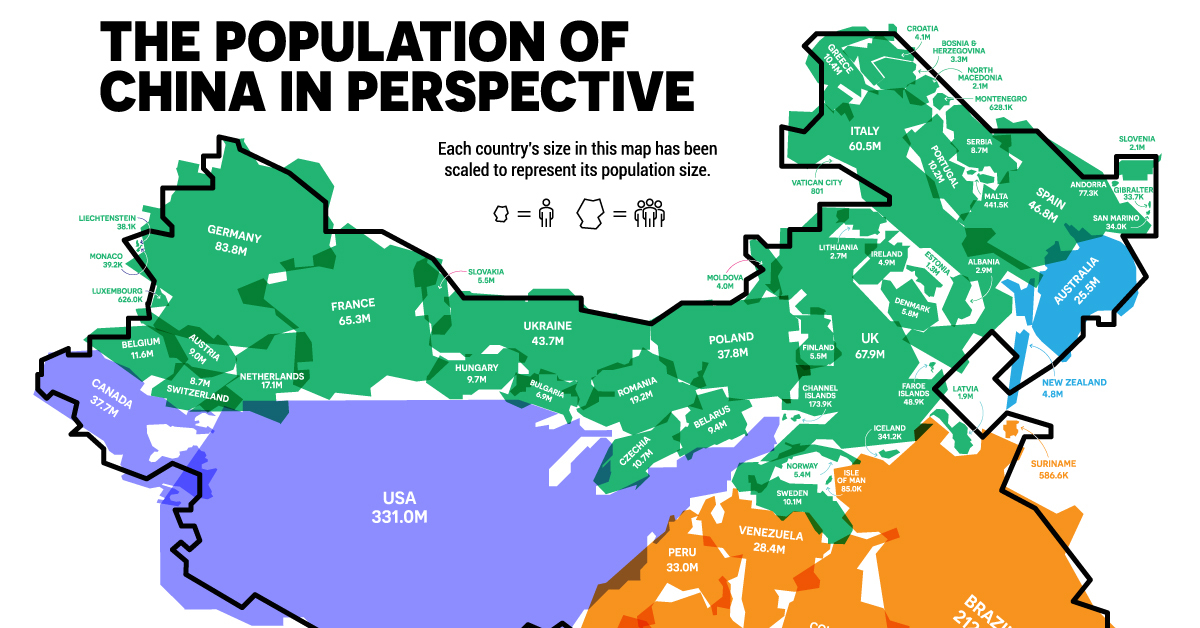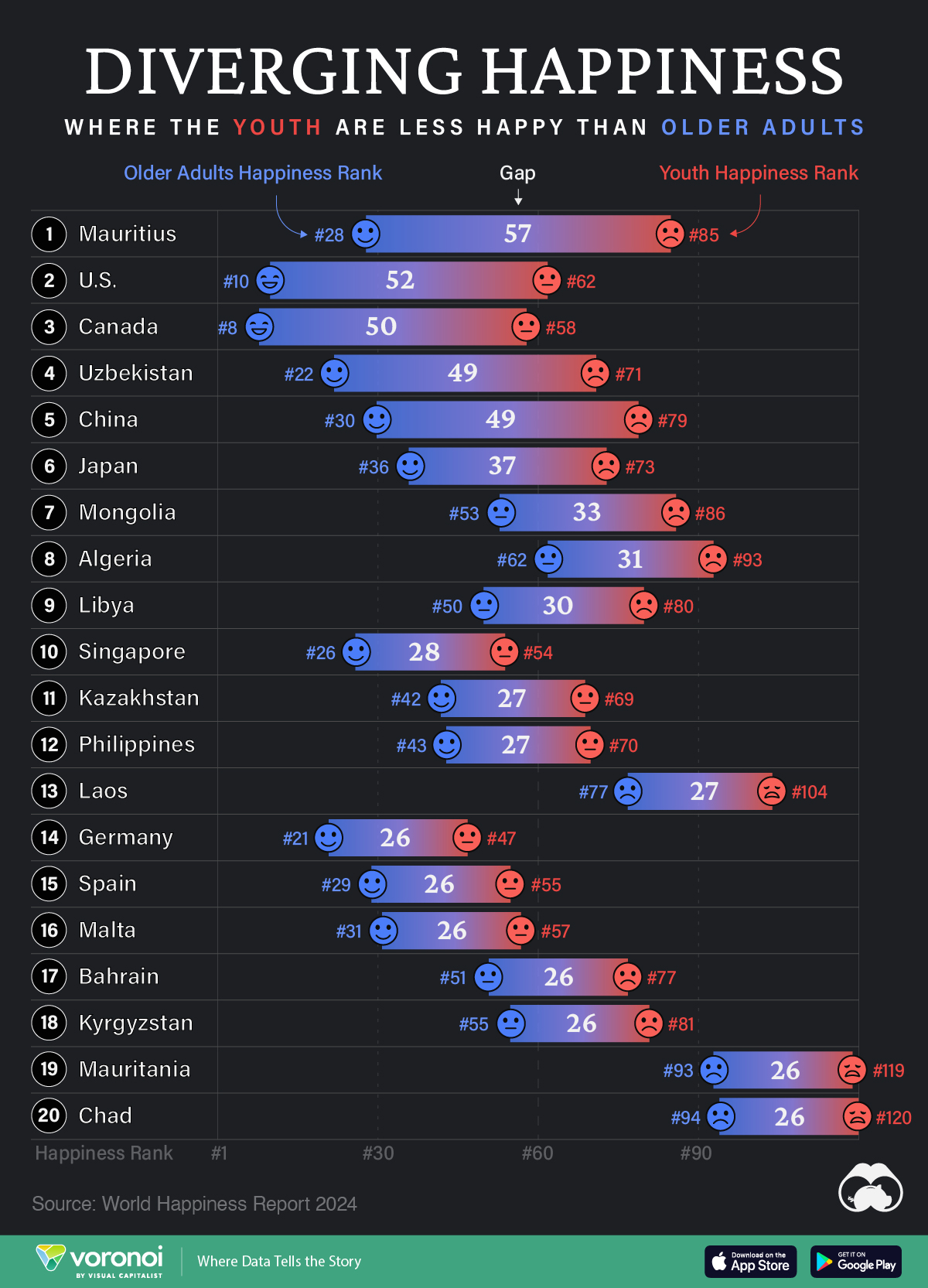Demographics
The Population of China in Perspective
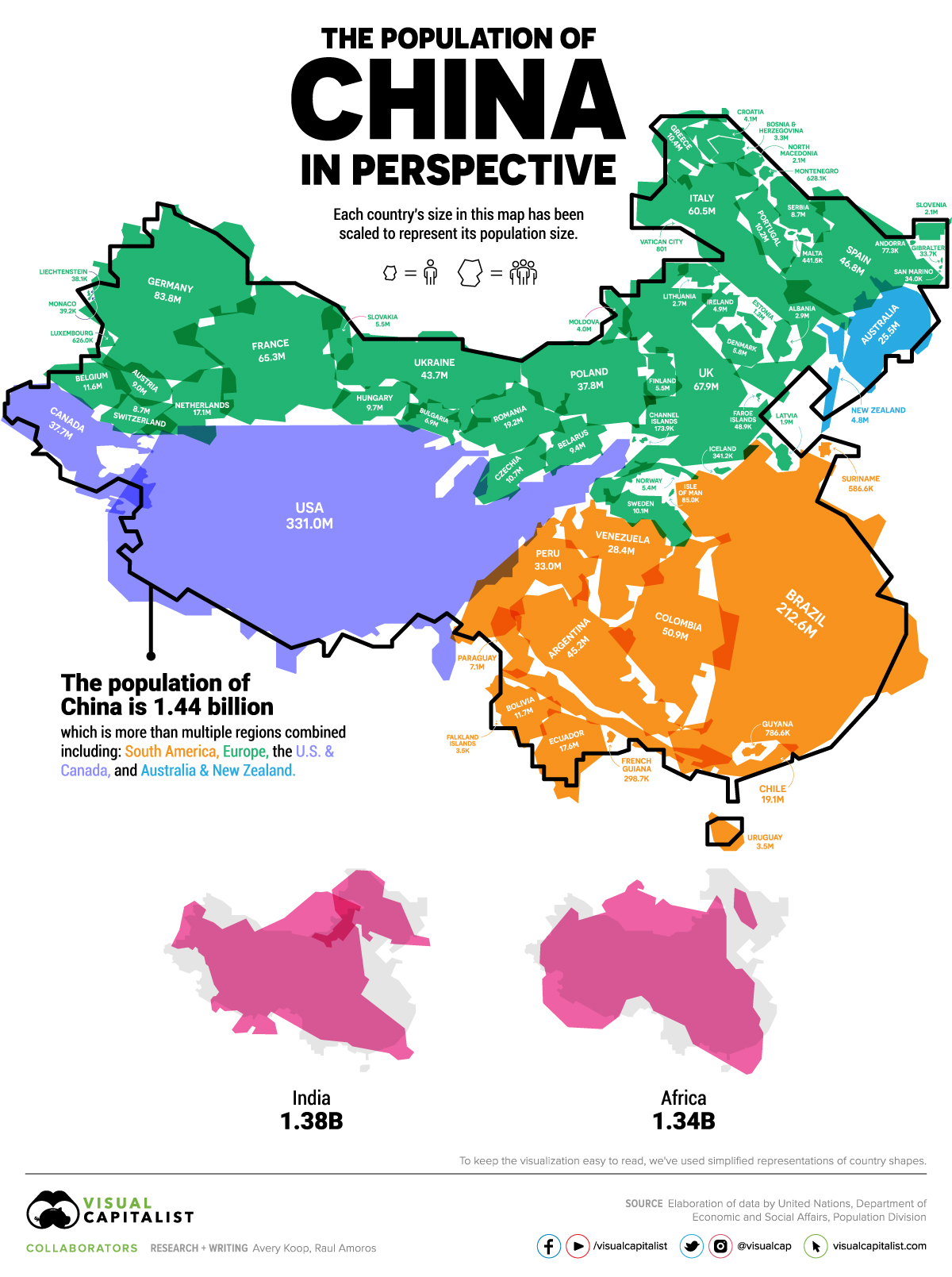
The Population of China in Perspective
China is the world’s most populous country with an astounding 1.44 billion citizens. Altogether, the size of the population of China is larger than nearly four regions combined: South America, Europe (excluding Russia), the U.S. & Canada, and Australia & New Zealand.
Using data from the United Nations, this unconventional map reveals the comparative size of China’s population next to a multitude of other countries.
Note: To keep the visualization easy to read, we’ve simplified the shapes representing countries. For example, although we’ve included Alaska and Hawaii in U.S. population totals, the U.S. is represented by the contiguous states map only.
A Historical Perspective
Looking at history, the population of China has more than doubled since the 1950s. The country was the first in the world to hit one billion people in 1980.
However, in 1979, in an attempt to control the burgeoning population, the infamous one-child policy was introduced, putting controls on how many children Chinese citizens could have.
While the government eventually recognized the negative implications of this policy, it appeared to be too little, too late. The two-child policy was introduced in 2016, but it has not yet reversed the current slowdown in population growth.
| Year | China's Population (Millions) | Annual Rate of Growth (%) | Median Age | Fertility Rate |
|---|---|---|---|---|
| 1955 | 612.2 | 2.00% | 22.2 | 6.11 |
| 1960 | 660.4 | 1.53% | 21.3 | 5.48 |
| 1965 | 724.2 | 1.86% | 19.8 | 6.15 |
| 1970 | 827.6 | 2.70% | 19.3 | 6.30 |
| 1975 | 926.2 | 2.28% | 20.3 | 4.85 |
| 1980 | 1,000.1 | 1.55% | 21.9 | 3.01 |
| 1985 | 1,075.6 | 1.47% | 23.5 | 2.52 |
| 1990 | 1,176.9 | 1.82% | 24.9 | 2.73 |
| 1995 | 1,240.9 | 1.07% | 27.4 | 1.83 |
| 2000 | 1,290.6 | 0.79% | 30.0 | 1.62 |
| 2005 | 1,330.8 | 0.62% | 32.6 | 1.61 |
| 2010 | 1,368.8 | 0.57% | 35.0 | 1.62 |
| 2015 | 1,406.8 | 0.55% | 36.7 | 1.64 |
| 2016 | 1,414.0 | 0.51% | 37.0 | 1.65 |
| 2017 | 1,421.0 | 0.49% | 37.0 | 1.65 |
| 2018 | 1,427.6 | 0.47% | 37.0 | 1.65 |
| 2019 | 1,433.8 | 0.43% | 37.0 | 1.65 |
| 2020 | 1,439.3 | 0.39% | 38.4 | 1.69 |
The fertility rate has been consistently falling from over 6 births per woman in 1955 to 1.69 in 2020. Today, the median age in China is 38 years old, rising from 22 in 1955. Longer life spans and fewer births form a demographic trend that has many social and economic implications.
Overall, China’s young population is becoming scarcer, meaning that the domestic labor market will eventually begin shrinking. Additionally, the larger share of elderly citizens will require publicly-funded resources, resulting in a heavier societal and financial burden.
Strength in Numbers
Despite these trends, however, China’s current population remains massive, constituting almost 20% of the world’s total population. Right now 71% of the Chinese population is between the ages of 15 and 65 years old, meaning that the labor supply is still immense.
Here are the populations of 65 countries from various regions of the world—and added together, you’ll see they still fall short of the population of China:
| Country | Population | Region |
|---|---|---|
| 🇺🇸 U.S. | 331,002,651 | North America |
| 🇨🇦 Canada | 37,742,154 | North America |
| 🇧🇷 Brazil | 212,559,417 | South America |
| 🇨🇴 Colombia | 50,882,891 | South America |
| 🇦🇷 Argentina | 45,195,774 | South America |
| 🇵🇪 Peru | 32,971,854 | South America |
| 🇻🇪 Venezuela | 28,435,940 | South America |
| 🇨🇱 Chile | 19,116,201 | South America |
| 🇪🇨 Ecuador | 17,643,054 | South America |
| 🇧🇴 Bolivia | 11,673,021 | South America |
| 🇵🇾 Paraguay | 7,132,538 | South America |
| 🇺🇾 Uruguay | 3,473,730 | South America |
| 🇬🇾 Guyana | 786,552 | South America |
| 🇸🇷 Suriname | 586,632 | South America |
| 🇬🇫 French Guyana | 298,682 | South America |
| 🇫🇰 Falkland Islands | 3,480 | South America |
| 🇦🇺 Australia | 25,499,884 | Oceania |
| 🇳🇿 New Zealand | 4,822,233 | Oceania |
| 🇩🇪 Germany | 83,783,942 | Europe |
| 🇫🇷 France | 65,273,511 | Europe |
| 🇳🇱 Netherlands | 17,134,872 | Europe |
| 🇧🇪 Belgium | 11,589,623 | Europe |
| 🇦🇹 Austria | 9,006,398 | Europe |
| 🇨🇭 Switzerland | 8,654,622 | Europe |
| 🇱🇺 Luxembourg | 625,978 | Europe |
| 🇲🇨 Monaco | 39,242 | Europe |
| 🇱🇮 Liechtenstein | 38,128 | Europe |
| 🇮🇹 Italy | 60,461,826 | Europe |
| 🇪🇸 Spain | 46,754,778 | Europe |
| 🇬🇷 Greece | 10,423,054 | Europe |
| 🇵🇹 Portugal | 10,196,709 | Europe |
| 🇷🇸 Serbia | 8,737,371 | Europe |
| 🇭🇷 Croatia | 4,105,267 | Europe |
| 🇧🇦 Bosnia and Herzegovina | 3,280,819 | Europe |
| 🇦🇱 Albania | 2,877,797 | Europe |
| 🇲🇰 North Macedonia | 2,083,374 | Europe |
| 🇸🇮 Slovenia | 2,078,938 | Europe |
| 🇲🇪 Montenegro | 628,066 | Europe |
| 🇲🇹 Malta | 441,543 | Europe |
| 🇦🇩 Andorra | 77,265 | Europe |
| 🇸🇲 San Marino | 33,931 | Europe |
| 🇬🇮 Gibraltar | 33,691 | Europe |
| 🇻🇦 Vatican City | 801 | Europe |
| 🇬🇧 United Kingdom | 67,886,011 | Europe |
| 🇸🇪 Sweden | 10,099,265 | Europe |
| 🇩🇰 Denmark | 5,792,202 | Europe |
| 🇫🇮 Finland | 5,540,720 | Europe |
| 🇳🇴 Norway | 5,421,241 | Europe |
| 🇮🇪 Ireland | 4,937,786 | Europe |
| 🇱🇹 Lithuania | 2,722,289 | Europe |
| 🇱🇻 Latvia | 1,886,198 | Europe |
| 🇪🇪 Estonia | 1,326,535 | Europe |
| 🇮🇸 Iceland | 341,243 | Europe |
| Channel Islands | 173,863 | Europe |
| 🇮🇲 Isle of Man | 85,033 | Europe |
| 🇫🇴 Faroe Islands | 48,863 | Europe |
| 🇺🇦 Ukraine | 43,733,762 | Europe |
| 🇵🇱 Poland | 37,846,611 | Europe |
| 🇷🇴 Romania | 19,237,691 | Europe |
| 🇨🇿 Czechia | 10,708,981 | Europe |
| 🇭🇺 Hungary | 9,660,351 | Europe |
| 🇧🇾 Belarus | 9,449,323 | Europe |
| 🇧🇬 Bulgaria | 6,948,445 | Europe |
| 🇸🇰 Slovakia | 5,459,642 | Europe |
| 🇲🇩 Moldova | 4,033,963 | Europe |
| Total | 1,431,528,252 |
To break it down even further, here’s a look at the population of each of the regions listed above:
- Australia and New Zealand: 30.3 million
- Europe (excluding Russia): 601.7 million
- South America: 430.8 million
- The U.S. and Canada: 368.7 million
Combined their population is 1.432 billion compared to China’s 1.439 billion.
Overall, the population of China has few comparables. India is one exception, with a population of 1.38 billion. As a continent, Africa comes in close as well at 1.34 billion people. Here’s a breakdown of Africa’s population for further comparison.
| Country | Population | Region |
|---|---|---|
| 🇳🇬 Nigeria | 206,139,589 | Africa |
| 🇬🇭 Ghana | 31,072,940 | Africa |
| 🇨🇮 Côte d'Ivoire | 26,378,274 | Africa |
| 🇳🇪 Niger | 24,206,644 | Africa |
| 🇧🇫 Burkina Faso | 20,903,273 | Africa |
| 🇲🇱 Mali | 20,250,833 | Africa |
| 🇸🇳 Senegal | 16,743,927 | Africa |
| 🇬🇳 Guinea | 13,132,795 | Africa |
| 🇧🇯 Benin | 12,123,200 | Africa |
| 🇹🇬 Togo | 8,278,724 | Africa |
| 🇸🇱 Sierra Leone | 7,976,983 | Africa |
| 🇱🇷 Liberia | 5,057,681 | Africa |
| 🇲🇷 Mauritania | 4,649,658 | Africa |
| 🇬🇲 Gambia | 2,416,668 | Africa |
| 🇬🇼 Guinea-Bissau | 1,968,001 | Africa |
| 🇨🇻 Cabo Verde | 555,987 | Africa |
| 🇸🇭 Saint Helena | 6,077 | Africa |
| 🇿🇦 South Africa | 59,308,690 | Africa |
| 🇳🇦 Namibia | 2,540,905 | Africa |
| 🇧🇼 Botswana | 2,351,627 | Africa |
| 🇱🇸 Lesotho | 2,142,249 | Africa |
| 🇸🇿 Eswatini | 1,160,164 | Africa |
| 🇪🇬 Egypt | 102,334,404 | Africa |
| 🇩🇿 Algeria | 43,851,044 | Africa |
| 🇸🇩 Sudan | 43,849,260 | Africa |
| 🇲🇦 Morocco | 36,910,560 | Africa |
| 🇹🇳 Tunisia | 11,818,619 | Africa |
| 🇱🇾 Libya | 6,871,292 | Africa |
| 🇪🇭 Western Sahara | 597,339 | Africa |
| 🇨🇩 Democratic Republic of the Congo | 89,561,403 | Africa |
| 🇦🇴 Angola | 32,866,272 | Africa |
| 🇨🇲 Cameroon | 26,545,863 | Africa |
| 🇹🇩 Chad | 16,425,864 | Africa |
| 🇨🇬 Congo | 5,518,087 | Africa |
| 🇨🇫 Central African Republic | 4,829,767 | Africa |
| 🇬🇦 Gabon | 2,225,734 | Africa |
| 🇬🇶 Equatorial Guinea | 1,402,985 | Africa |
| 🇸🇹 Sao Tome and Principe | 219,159 | Africa |
| 🇪🇹 Ethiopia | 114,963,588 | Africa |
| 🇹🇿 Tanzania | 59,734,218 | Africa |
| 🇰🇪 Kenya | 53,771,296 | Africa |
| 🇺🇬 Uganda | 45,741,007 | Africa |
| 🇲🇿 Mozambique | 31,255,435 | Africa |
| 🇲🇬 Madagascar | 27,691,018 | Africa |
| 🇲🇼 Malawi | 19,129,952 | Africa |
| 🇿🇲 Zambia | 18,383,955 | Africa |
| 🇸🇴 Somalia | 15,893,222 | Africa |
| 🇿🇼 Zimbabwe | 14,862,924 | Africa |
| 🇷🇼 Rwanda | 12,952,218 | Africa |
| 🇧🇮 Burundi | 11,890,784 | Africa |
| 🇸🇸 South Sudan | 11,193,725 | Africa |
| 🇪🇷 Eritrea | 3,546,421 | Africa |
| 🇲🇺 Mauritius | 1,271,768 | Africa |
| 🇩🇯 Djibouti | 988,000 | Africa |
| 🇷🇪 Réunion | 895,312 | Africa |
| 🇰🇲 Comoros | 869,601 | Africa |
| 🇾🇹 Mayotte | 272,815 | Africa |
| 🇸🇨 Seychelles | 98,347 | Africa |
| Total | 1,340,598,147 |
Future Outlook on the Population of China
Whether or not China’s population growth is slowing appears to be less relevant when looking at its sheer size. While India is expected to match the country’s population by 2026, China will remain one of the world’s largest economic powerhouses regardless.
It is estimated, however, that the population of China will drop below one billion people by the year 2100—bumping the nation to third place in the ranking of the world’s most populous countries. At the same time, it’s possible that China’s economic dominance may be challenged by these same demographic tailwinds as time moves forward.
Demographics
Ranked: Countries Where Youth are the Most Unhappy, Relative to Older Generations
Conventional wisdom says that young adults (those below 30) tend to be the happiest demographic—but this is not true for these countries.
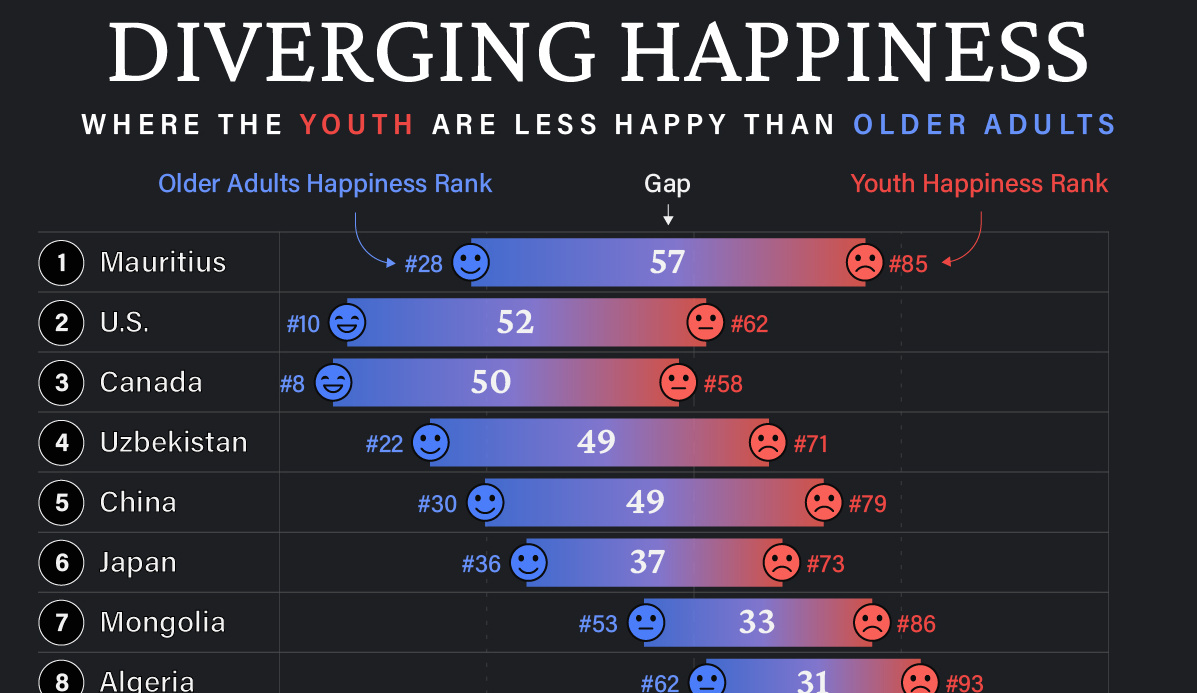
Countries with the Biggest Happiness Gaps Between Generations
This was originally posted on our Voronoi app. Download the app for free on iOS or Android and discover incredible data-driven charts from a variety of trusted sources.
“They say a person needs just three things to be truly happy in this world: someone to love, something to do, and something to hope for.” — Tom Bodett
Measuring happiness is tricky business, more so when taking into account how different regions, cultures, and faiths define it. Nevertheless, the World Happiness Report attempts to distill being happy into a single score out of 10, and then ranks countries by their average score.
We’ve visualized the high-level findings from the latest happiness report in this series of maps. However, the report also dives deeper into other significant trends in the data, such as a growing disparity in happiness between age groups within countries themselves.
In the chart above, we list countries by the biggest gaps in happiness ranks between young adults (<30) and older adults (60+). A higher number indicates a larger gap, and that the youth are far unhappier than their older counterparts.
Where are Youth Unhappier than Older Adults?
Mauritius ranks first on this list, with a massive 57 place gap between older adult and youth happiness. The 1.26 million-inhabited island nation briefly reached high income status in 2020, but the pandemic hit hard, hurting its key tourism sector, and affecting jobs.
The country’s youth unemployment rate spiked to close to 25% that year, but has since been on the decline. Like residents on many similarly-populated islands, the younger demographic often moves abroad in search of more opportunities.
| Rank | Country | Youth Happiness Rank | Older Adult Happiness Rank | Happiness Gap |
|---|---|---|---|---|
| 1 | 🇲🇺 Mauritius | 85 | 28 | 57 |
| 2 | 🇺🇸 U.S. | 62 | 10 | 52 |
| 3 | 🇨🇦 Canada | 58 | 8 | 50 |
| 4 | 🇺🇿 Uzbekistan | 71 | 22 | 49 |
| 5 | 🇨🇳 China | 79 | 30 | 49 |
| 6 | 🇯🇵 Japan | 73 | 36 | 37 |
| 7 | 🇲🇳 Mongolia | 86 | 53 | 33 |
| 8 | 🇩🇿 Algeria | 93 | 62 | 31 |
| 9 | 🇱🇾 Libya | 80 | 50 | 30 |
| 10 | 🇸🇬 Singapore | 54 | 26 | 28 |
| 11 | 🇰🇿 Kazakhstan | 69 | 42 | 27 |
| 12 | 🇵🇭 Philippines | 70 | 43 | 27 |
| 13 | 🇱🇦 Laos | 104 | 77 | 27 |
| 14 | 🇩🇪 Germany | 47 | 21 | 26 |
| 15 | 🇪🇸 Spain | 55 | 29 | 26 |
| 16 | 🇲🇹 Malta | 57 | 31 | 26 |
| 17 | 🇧🇭 Bahrain | 77 | 51 | 26 |
| 18 | 🇰🇬 Kyrgyzstan | 81 | 55 | 26 |
| 19 | 🇲🇷 Mauritania | 119 | 93 | 26 |
| 20 | 🇹🇩 Chad | 120 | 94 | 26 |
Conventional wisdom says, and data somewhat correlates, that young adults (those below 30) tend to be the happiest demographic. Happiness then decreases through middle age and starts increasing around 60. However, the above countries are digressing from the pattern, with older generations being much happier than young adults.
That older generations are happier, by itself, is not a bad thing. However, that younger adults are so much unhappier in the same country can point to several unique stresses that those aged below 30 are facing.
For example, in the U.S. and Canada—both near the top of this list—many young adults feel like they have been priced out of owning a home: a once key metric of success.
Climate anxieties are also high, with worries about the future of the world they’ll inhabit. Finally, persistent economic inequities are also weighing on the younger generation, with many in that cohort feeling like they will never be able to afford to retire.
All of this comes alongside a rising loneliness epidemic, where those aged 18–25 report much higher rates of loneliness than the general population.
Source: The World Happiness Report which leverages data from the Gallup World Poll.
Methodology: A nationally representative group of approximately 1,000 people per country are asked to evaluate their life on a scale of 0–10. Scores are averaged across generations per country over three years. Countries are ranked by their scores out of 10.
-
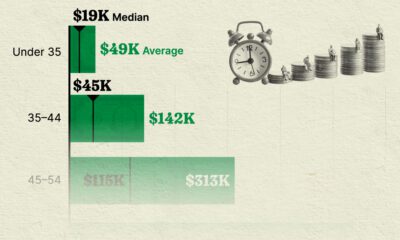
 Money1 week ago
Money1 week agoVisualizing America’s Average Retirement Savings, by Age
-

 Economy2 weeks ago
Economy2 weeks agoVisualizing the Tax Burden of Every U.S. State
-

 Automotive2 weeks ago
Automotive2 weeks agoHow People Get Around in America, Europe, and Asia
-

 Economy2 weeks ago
Economy2 weeks agoMapped: Southeast Asia’s GDP Per Capita, by Country
-

 Demographics2 weeks ago
Demographics2 weeks agoMapped: U.S. Immigrants by Region
-

 Healthcare2 weeks ago
Healthcare2 weeks agoWhich Countries Have the Highest Infant Mortality Rates?
-

 Misc2 weeks ago
Misc2 weeks agoCharted: How Americans Feel About Federal Government Agencies
-

 Mining2 weeks ago
Mining2 weeks agoVisualizing Copper Production by Country in 2023




